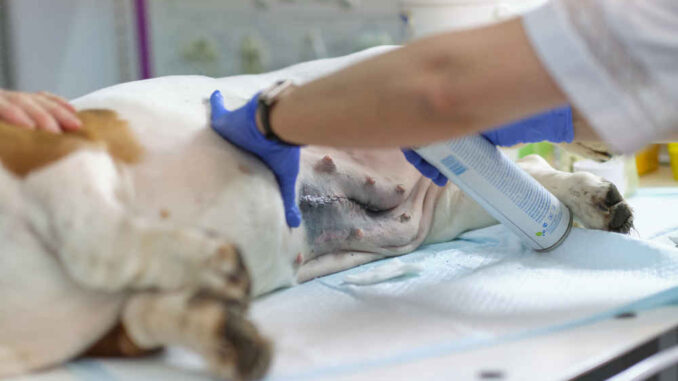
This article was updated on May 24th, 2023
As a veterinarian of 17 years, I have seen thousands of dogs with wounds ranging from small to large and life-threatening. In this article, I will share my tips for healing dog wounds quickly.
To start with, you should know that there is no easy way to speed up the healing of a wound artificially: the work of healing a dog’s wound must be done by the body. Different dogs and different wounds will heal at various paces. An owner’s job is to facilitate healing and prevent infection.
Optimal wound healing requires that:
- the wound is kept clean and
- the infection is controlled.
Some wounds may need to be covered with bandages, but the majority of minor wounds need to be left uncovered. Ensuring that the dog is well-rested and eating a nutritious, well-balanced diet is also essential.
What you can do at home to help your dog’s wound heal quickly and without any issue
If your dog has suffered a minor wound or scrape, it may be able to be treated at home. If the wound is truly minor, all that is necessary is cleaning your dog’s wound (daily), and watching for signs of infection or worsening.
1. Cleaning your dog’s wound (daily)
First, the wound should be cleaned with water. To clean the wound, you may use a clean, moist washcloth to wipe away and dirt or debris. Avoid covering the wound or using topical medications / hydrogen peroxide / soap / alcohol.
After washing and evaluation, you should take your dog to see their veterinarian if the wound is:
- deep,
- still bleeding,
- a puncture,
- seems infected, or
- is located on or near a sensitive area such as the face, ear, underarm, groin, near the genitals, or over a joint.
2. Watching for signs of infection or worsening.
It’s important to monitor your dog’s wound to ensure fast healing. Regardless of whether or not veterinary care was needed initially for a dog’s wound, there are things that the owner needs to be aware of during the healing process. The wound should be monitored at least daily for:
- redness,
- swelling,
- streaking,
- pus, and
- enlargement.
Check out our article about the 4 Dog Wound Healing Stages [With Pictures]. If any signs of delayed or poor wound healing are noted, the dog should be taken to a veterinarian as soon as possible.
How can I speed up my dog’s wound healing?
Unfortunately, it is not possible to easily speed up the healing of a dog’s wound. Once injured, the dog’s body will have to heal the wound. There are many factors affecting this healing. You can support your dog’s healing process by:
- keeping the wound clean
- Keeping the wound dry
- having the dog rest, and
- feeding them a balanced diet.
If complications arise, your veterinarian should be consulted as soon as possible.
What is the best over-the-counter or natural medicine for dog wounds?
I do not recommend any over-the-counter products for dog wounds. If a wound is severe enough to need medication, the dog should be taken to a veterinarian. Topical products made for humans can be unsafe, and dog-specific products often do more harm than good. Minor wounds will heal on their own unless there is a secondary complication.
What should I do if my dog’s wound is bleeding?
If your dog injures itself and the wound is bleeding, you should immediately try to stop the bleeding by applying direct pressure to the wound with a clean cloth or gauze.
Caution should be exercised as a dog in pain may bite. Pressure should be kept on the wound until veterinary assistance can be obtained.
If the wound is on the head or a leg, it may be helpful to elevate the affected area above the level of the heart. This elevation will help decrease the rate of bleeding. Never place a tourniquet on a dog as more complications may ensue.
Costs of treating dog wounds at the veterinarian
Treatments vary widely, from clipping and cleaning to major surgery. The costs incurred will depend on the size and severity of the wound, if the wound is infected, and the overall health of the pet. Costs incurred may range from $100 to thousands.
If your dog is covered by pet insurance, the treatments performed by the veterinarian may be covered, depending on the plan purchased.
What about pain medications?
Pain is certainly an expected part of a wound. If needed, your veterinarian will prescribe appropriate pain medications.
Dogs should never be given human over-the-counter or prescription medications. Dogs are not small humans, and these medications may require different doses and are often even toxic. You should never give ibuprofen or naproxen to a dog. Aspirin should be avoided as well, even if labeled for dogs, as it is not an effective pain reliever for them at safe doses, and it easily causes significant adverse effects such as bleeding and gastrointestinal ulceration.
What are the factors that affect the rate of the wound healing stages in dogs?
There are many factors that affect how quickly a dog’s wound will heal.
- The depth, width, and length of the wound are major factors that affect healing time.
- Whether or not the wound was able to be closed with sutures,
- location on the body,
- presence or absence of infection, and the
- overall health status of the dog all play a role in the speed of wound healing.
Visiting an emergency veterinarian
If an injury to your dog occurs after hours, you may need to visit an emergency hospital. Indications for an emergency visit include bleeding that is heavy or will not easily stop in the initial 5-10 minutes, deep or penetrating injuries, lacerations longer than ½ inch, and any other trauma such as broken bones or head injuries that may accompany the wound.
Can you treat an open wound without going to the vet?
All open wounds should be examined by a veterinarian. It is impossible for a pet parent to determine the depth and severity of an open wound. You will also not be able to tell if any vital structures, such as blood vessels, muscle, tendons, or nerves have been damaged.
How to evaluate if your dog need stitches
Whether or not your dog’s wound requires stitches depends on many variables. These include:
• Size: Stitches may be required if the wound is deep, more than a half-inch long, gaping, has uneven edges, or has foreign material in it.
• Bleeding: If the bleeding does not stop with gentle pressure within the first 5-10 minutes, your dog may need stitches.
• Cause: It is important to tell your veterinarian what caused the wound, as this will play a role in determining if the wound should be stitched or not.
• Location: Wounds on the head, ears, over joints, near the genitals, and in the underarms and groin are more likely to need stitches.
How will my dog’s wound be treated at the vet?
Treating your dog’s wound will depend highly on the type of wound, location, size, and other factors. When possible, most wounds will be sutured in order to speed the healing process and to avoid infection. Abscesses may need to be lanced and cleaned to allow for healing.
Depending on the state of the wound and other factors, sedation, flushing, debridement (removal of dead tissue), and other procedures may be necessary. Antibiotics and pain medications will be prescribed as necessary. Some wounds may require bandaging.
FAQs
Should I let my dog lick his wounds? Your dog should not be allowed to lick an open wound. Licking a wound is likely to lead to infection and a worsening of the wound. Ask your veterinarian about methods to curtail licking, such as an Elizabethan collar. Depending on the site of the wound, baby onesies, t-shirts, or dog sweaters may be an option to prevent licking.
Does a dog licking a wound help it heal faster? No, a dog licking a wound will not help it heal faster. Dogs, like humans, carry many bacteria in their mouths, and licking the wound is likely to damage it as well as seed infection.
Related posts:
Disclaimer: This website's content is not a substitute for veterinary care. Always consult with your veterinarian for healthcare decisions. Read More.



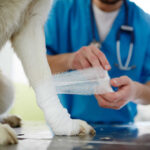

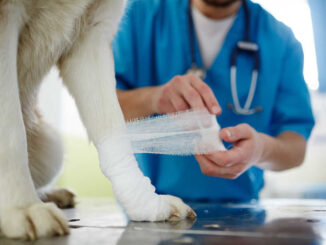
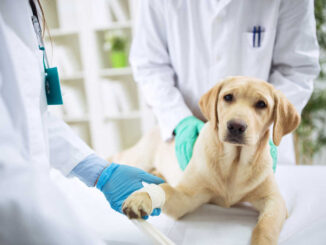
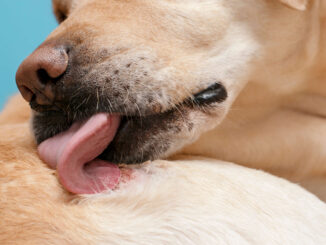
Be the first to comment